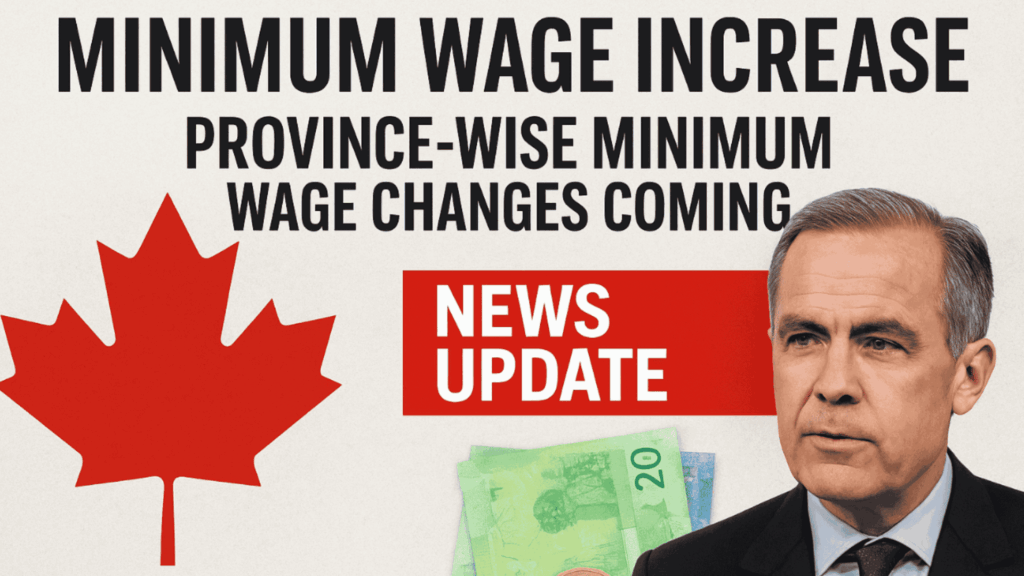The minimum wage increase in Canada has become a major topic in 2025 as provinces prepare to implement new rates. Workers and employers alike are keen to know the province-wise changes and how these adjustments will affect their income and costs.
Minimum Wage Increase Canada
Minimum wage in Canada is reviewed regularly to ensure that workers are fairly compensated in line with rising living costs. In 2025, several provinces have announced new rates, giving employees across different regions a much-needed financial boost.
These changes are not the same everywhere, as each province decides its own wage structure depending on its economy, affordability, and workforce needs. Understanding these province-wise updates is important for both employees and businesses.
Why Minimum Wage is Increasing in 2025
The decision to raise minimum wages in 2025 is largely tied to inflation and the need to maintain workers’ purchasing power. With groceries, utilities, and rent prices steadily climbing, wages must increase to ensure workers can afford essentials.
Beyond affordability, wage hikes also play a role in reducing poverty and improving the standard of living for Canadians. By adjusting rates every year or two, provinces aim to balance fairness for workers with sustainability for employers.
Province Wise Minimum Wage Changes
Different provinces and territories have announced their own minimum wage adjustments for 2025. Some are modest, while others reflect a stronger response to inflation and high living costs. The changes also consider local business conditions, ensuring wage increases are manageable.
Here is a summary of the expected changes:
Province/Territory |
Current Rate (2024) |
New Rate (2025) |
Effective Date |
|---|---|---|---|
Ontario |
$16.55 |
$17.20 |
Nov 1, 2025 |
British Columbia |
$17.40 |
$17.90 |
Jun 1, 2025 |
Alberta |
$15.00 |
$15.50 |
Oct 1, 2025 |
Quebec |
$15.75 |
$16.25 |
May 1, 2025 |
Manitoba |
$15.30 |
$15.80 |
Nov 1, 2025 |
Saskatchewan |
$15.00 |
$15.50 |
Nov 1, 2025 |
Nova Scotia |
$15.20 |
$15.70 |
Apr 1, 2025 |
New Brunswick |
$15.30 |
$15.80 |
Apr 1, 2025 |
Newfoundland & Labrador |
$15.20 |
$15.70 |
Nov 1, 2025 |
Prince Edward Island |
$15.40 |
$15.90 |
Apr 1, 2025 |
This table shows how each province is tailoring its approach. Ontario and British Columbia are leading with higher increases, reflecting their higher cost of living.
Who Benefits from the Wage Hike
The minimum wage hike is aimed at improving the lives of workers who are most vulnerable to cost-of-living pressures. This includes employees in industries like food service, hospitality, and retail, where many rely on entry-level wages.
For students and part-time workers, the change provides additional financial stability. Families with single or dual minimum-wage earners can also expect a small but meaningful improvement in their household income.
Impact on Businesses and Economy
For businesses, especially small and medium-sized ones, wage increases can mean higher operating costs. Restaurants, small shops, and service providers may feel the impact more than large corporations. Some employers may respond by adjusting staff schedules or increasing prices.
On the other hand, higher wages put more money into workers’ hands, boosting local economies. Increased consumer spending can benefit retailers, service providers, and communities overall, creating a cycle of growth despite the short-term costs.
Preparing for the Wage Adjustments
Workers should be prepared to check their pay slips once the new wage rates take effect. It is important to confirm that employers are following the updated regulations and that the increases are reflected correctly.
Employers, meanwhile, should start adjusting payroll systems and budgets ahead of the implementation dates. Governments are also offering guidance and resources to help businesses make a smooth transition.
The 2025 minimum wage increases highlight a collective effort to maintain balance between affordability and economic sustainability. While adjustments may present challenges, they are an important step toward ensuring financial security for Canadian workers.
Thank you for reading, and stay informed on further provincial updates regarding wages and employment laws.
For More Information Click Here




